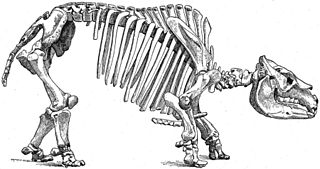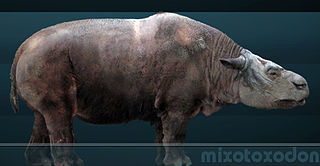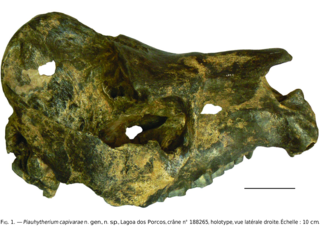
Toxodon is an extinct genus of South American mammals from the Late Miocene to early Holocene epochs. It is a member of Notoungulata, one of several now extinct orders of South American native ungulates distinct from living perissodactyls and artiodactyls. It was among the largest and last members of its order, and was probably the most common large hoofed mammal in South America of its time.

Notoungulata is an extinct order of mammalian ungulates that inhabited South America from the early Paleocene to the Holocene, living from approximately 61 million to 11,000 years ago. Notoungulates were morphologically diverse, with forms resembling animals as disparate as rabbits and rhinoceroses. Notoungulata are the largest group of South American native ungulates, with over 150 genera in 14 families having been described, divided into two major subgroupings, Typotheria and Toxodontia. Notoungulates first diversified during the Eocene. Their diversity declined from the late Neogene onwards, with only the large toxodontids persisting until the end of the Pleistocene, perishing as part of the Quaternary extinction event among with most other large mammals in the Americas. Collagen analysis suggests that notoungulates are closely related to litopterns, another group of South American ungulates, and their closest living relatives being perissodactyls, including rhinoceroses, tapirs and equines as part of the clade Panperissodactyla. However their relationships to other South American ungulates are uncertain. Several groups of notoungulates separately evolved ever-growing cheek teeth.

Toxodontia is a suborder of the meridiungulate order Notoungulata. Most of the members of the five included families, including the largest notoungulates, share several dental, auditory and tarsal specializations. The group is named after Toxodon, the first example of the group to be discovered by science.

South American native ungulates, commonly abbreviated as SANUs, are extinct ungulate-like mammals of controversial affinities that were indigenous to South America prior to the Great American Biotic Interchange. They comprise five major groups conventionally ranked as orders—Astrapotheria, Litopterna, Notoungulata, Pyrotheria, and Xenungulata—as well as the primitive "condylarth" groups Didolodontidae and Kollpaniinae. It has been proposed that some or all of the members of this group form a clade, named Meridiungulata, though the relationships of South American ungulates remain largely unresolved. The two largest groups of South American ungulates, the notoungulates and the litopterns, were the only groups to persist beyond the mid Miocene. Only a few of the largest species of notoungulates and litopterns survived until the end-Pleistocene extinction event around 12,000 years ago where they became extinct with most other large mammals in the Americas, shortly after the first arrival of humans into the region.

Toxodontidae is an extinct family of notoungulate mammals, known from the Oligocene to the Holocene of South America, with one genus, Mixotoxodon, also known from the Pleistocene of Central America and southern North America. Member of the family were medium to large-sized, ranging from around 350–400 kilograms (770–880 lb) in Nesodon to 1,000–1,200 kilograms (2,200–2,600 lb) in Toxodon, and had medium to high-crowned dentition, which in derived members of the group evolved into ever-growing cheek teeth. Isotopic analyses have led to the conclusion that Pleistocene members of the family were flexible mixed feeders.

Mesotheriidae is an extinct family of notoungulate mammals known from the Oligocene through the Pleistocene of South America. Mesotheriids were small to medium-sized herbivorous mammals adapted for digging.
The Deseadan age is a period of geologic time within the Oligocene epoch of the Paleogene to the Early Miocene epoch of the Neogene, used more specifically within the SALMA classification of South America. It follows the Tinguirirican and precedes the Colhuehuapian age.

Huilatherium is an extinct genus of leontiniid, a group of hoofed mammals belonging to the order Notoungulata, that comprises other South American ungulate families that evolved in parallel with some mammals of the Northern hemisphere. The leontiinids were a family of herbivorous species comprising medium to large browsers, with relatively short skulls and robust limbs, somewhat similar to their relatives, the best known toxodontids.
The Cuscatlán Formation is a geologic formation in El Salvador. It preserves fossils dating back to the Pliocene to Middle Pleistocene period.

Piauhytherium is an extinct genus of herbivorous notoungulate mammal of the family Toxodontidae. It lived during the Late Pleistocene; fossils have been found in Brazil. The only known species is Piauhytherium capivarae.

Hoffstetterius is an extinct genus of toxodontid notoungulate mammal, belonging to the subfamily Toxodontinae whose remains were discovered in the Middle to Late Miocene Mauri Formation in the La Paz Department in Bolivia. The only described species is the type Hoffstetterius imperator.
Falcontoxodon is an extinct genus of toxodontid notoungulate that lived from the late Pliocene to the Pleistocene in what is now Venezuela. Fossils of this genus have been found in the Chapadmalalan-Uquian Codore Formation, as well as in the more recent Ensenadan San Gregorio Formation.
Charruatoxodon is an extinct monotypic genus of notoungulate belonging to the family Toxodontidae. It lived from the Pliocene to the Early Pleistocene in what is now southern Uruguay. Its remains have been found in the San José member of the Raigón Formation, near Montevideo.
Proadinotherium is an extinct genus of toxodontid. It lived between the Late Oligocene and the Early Miocene in what is now South America.
Gyrinodon is an extinct genus of toxodontid notoungulate that lived from the Late Miocene and Early Pliocene in what is now Brazil and Colombia.
Pleurostylodon is an extinct genus of notoungulate belonging to the family Isotemnidae. It lived during the Middle Eocene, in what is now Argentina.
Rhyphodon is an extinct genus of notoungulate, who lived from the Middle to the Late Eocene in what is today South America.

Eomorphippus is an extinct genus of notohippid notoungulate that lived from the Late Eocene to the Early Oligocene in what is today South America.
Martinmiguelia is an extinct genus of Notoungulate, belonging to the family Leontiniidae. It lived during the Middle Eocene, and its fossil remains were found in South America.

Notopithecus is an extinct genus of Notoungulate, belonging to the suborder Typotheria. It lived from the Middle to the Late Eocene and its fossilized remains were discovered in South America.






















